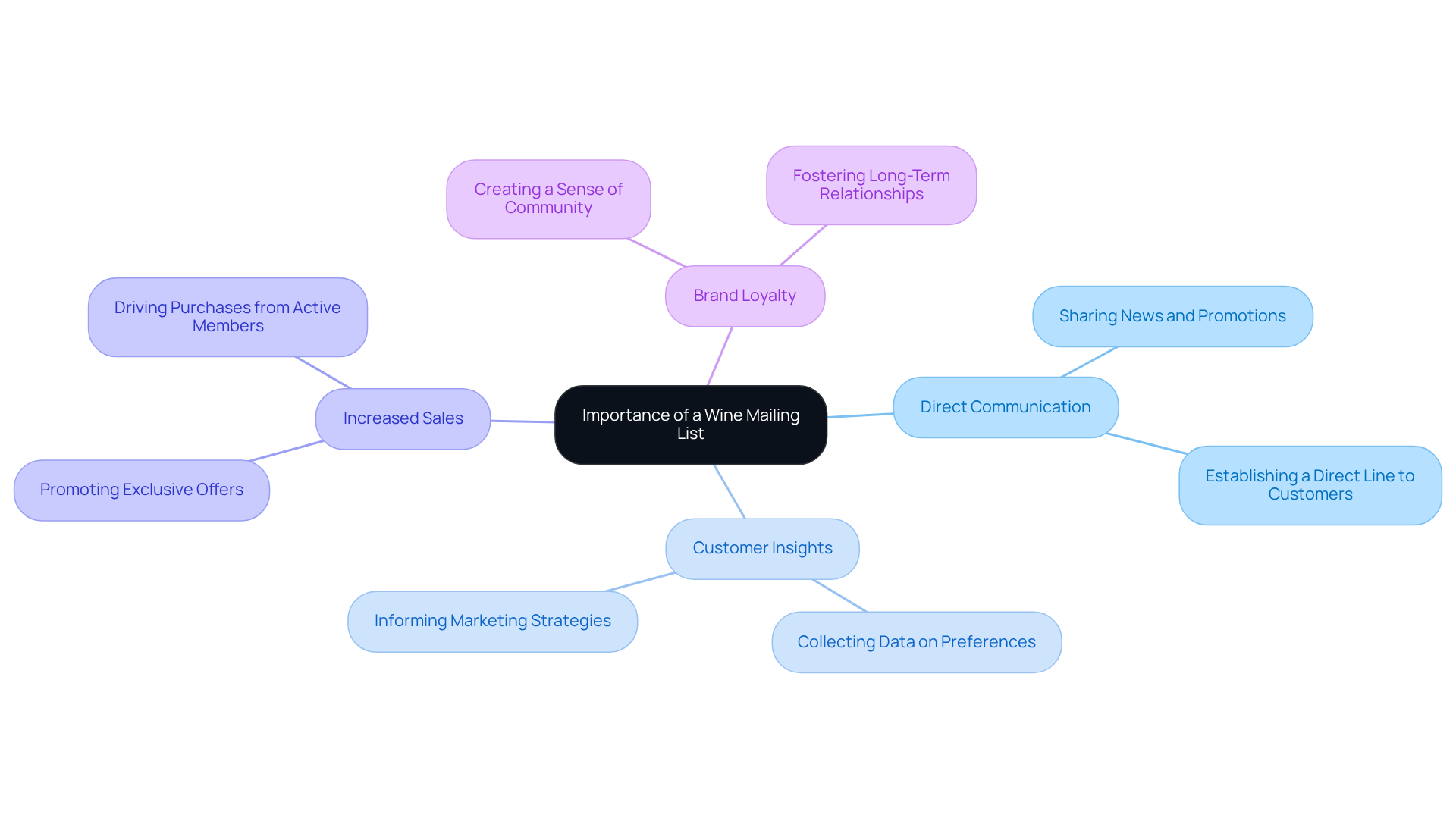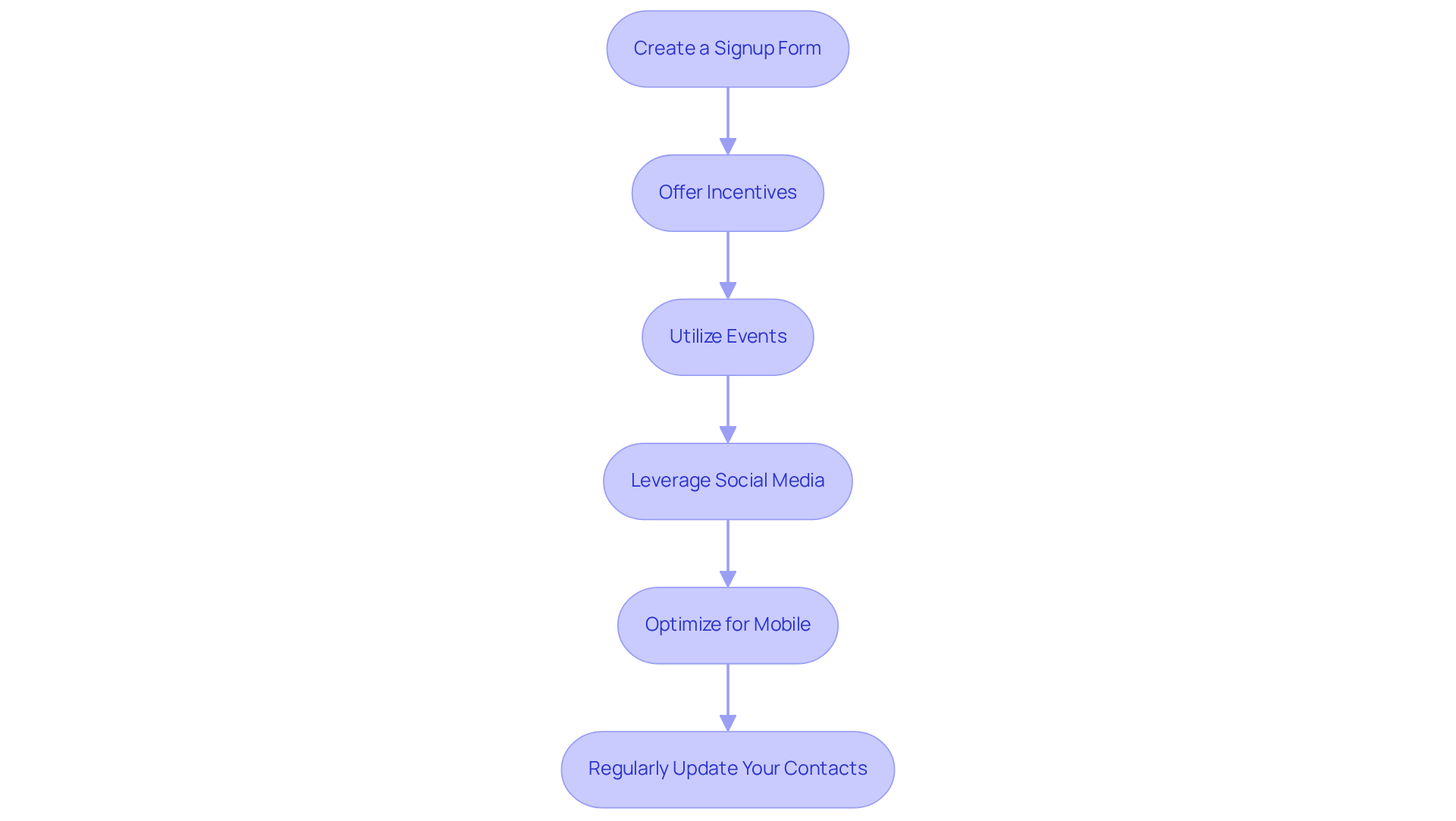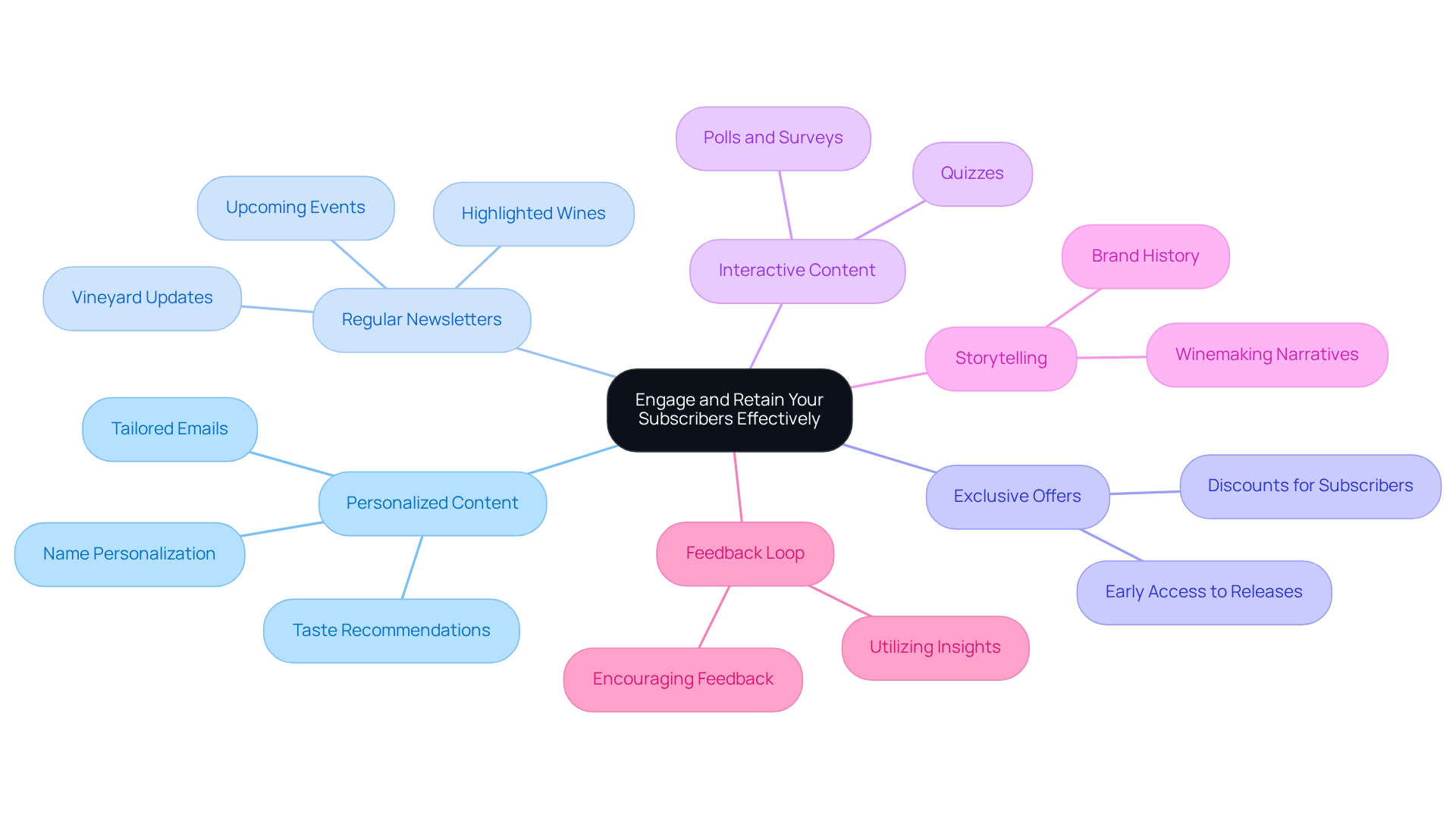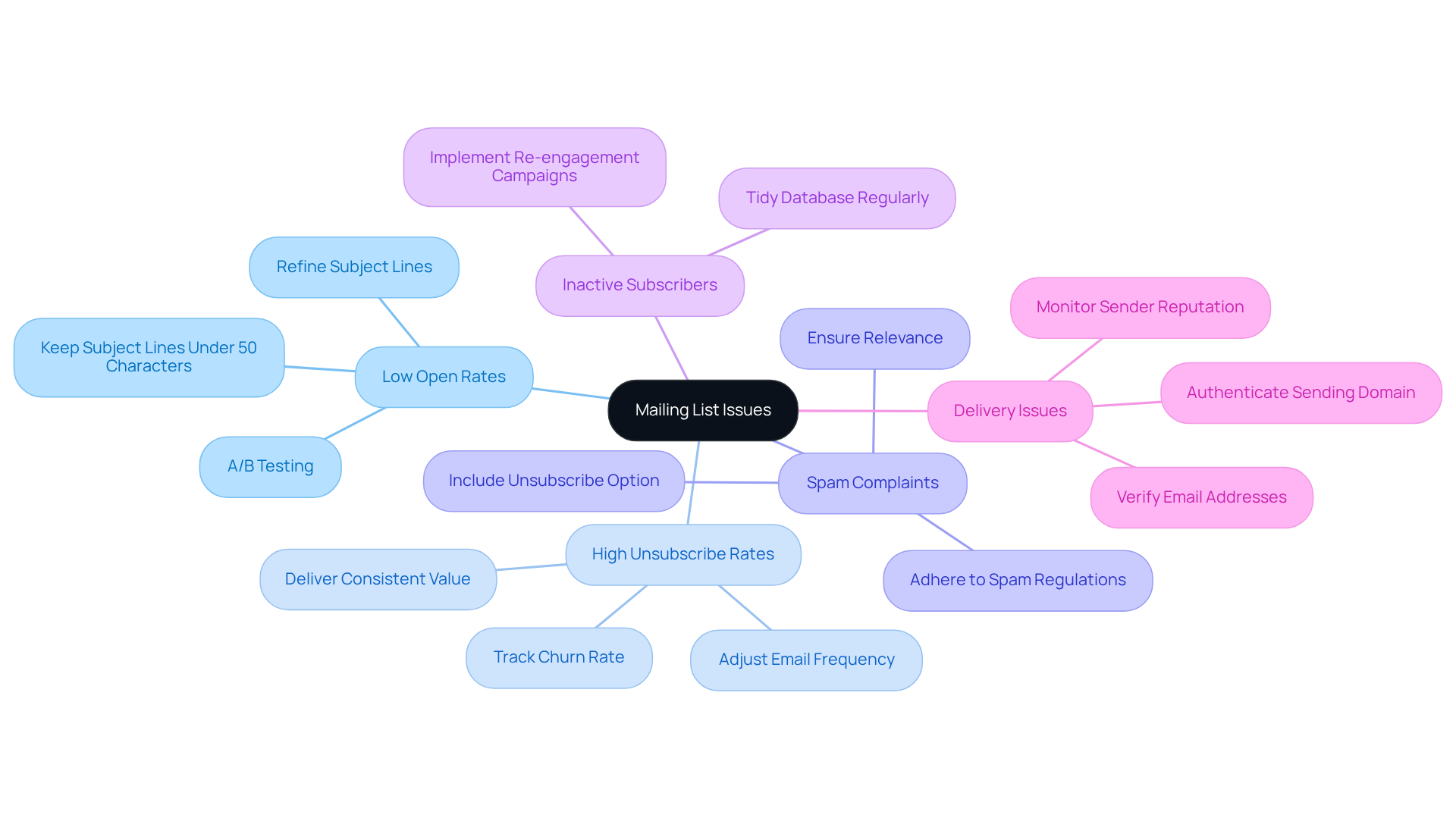Overview
The primary objective of this article is to deliver actionable steps that wineries can implement to effectively engage and retain subscribers on their wine mailing lists. To achieve this, the article outlines several strategic approaches:
- Crafting attractive signup forms
- Providing enticing incentives
- Leveraging personalized content
- Addressing prevalent mailing list challenges
Each of these strategies plays a crucial role in fostering robust customer relationships and driving sales growth.
Introduction
A wine mailing list transcends the mere collection of email addresses; it serves as a crucial conduit connecting vineyards with their most ardent customers. By harnessing this direct line of communication, wineries can disseminate exclusive offers, personalized content, and insights that resonate profoundly with their audience. This approach not only enhances customer loyalty but also drives sales. Yet, many vineyards grapple with the challenge of effectively engaging and retaining subscribers, resulting in missed opportunities to cultivate a thriving community around their brand.
What strategies can wineries adopt to not only expand their mailing lists but also convert casual buyers into devoted fans?
Understand the Importance of a Wine Mailing List
A wine mailing list serves as an essential communication channel between vineyards and their customers, facilitating the sharing of exclusive offers, new releases, and personalized content that resonates with the audience. By recognizing the importance of a wine mailing list, vineyards can harness its potential to increase sales, improve customer loyalty, and cultivate a community around their brand. A well-maintained wine mailing list not only results in greater engagement rates but also attracts individuals who are genuinely interested in the narratives and products related to their favorite wines. Furthermore, it provides valuable insights into customer preferences, enabling wineries to tailor their offerings effectively.
Key Benefits of a Wine Mailing List:
- Direct Communication: Establish a direct line to customers for sharing news and promotions.
- Customer Insights: Collect data on preferences and buying habits to inform marketing strategies.
- Increased Sales: Drive purchases by promoting exclusive offers to active members.
- Brand Loyalty: Create a sense of community among subscribers, fostering long-term relationships.
Successful vineyards have demonstrated that effective wine mailing list strategies can significantly impact sales. For instance, data-driven email campaigns have been shown to enhance engagement rates and conversion, leading to increased revenue. By leveraging these insights, vineyards can refine their marketing efforts to resonate with their audience, drive sustained growth, and effectively promote their wine mailing list. Moreover, vineyards must navigate the complexities of compliance regulations when selling directly to consumers. Enocap assists vineyards in understanding these nuances, ensuring effective communication and engagement with customers. By addressing these challenges and implementing robust mailing strategies, vineyards can enhance their market presence and cultivate enduring relationships with their clients, ultimately benefiting from Enocap's strategic capital advisory services.

Build Your Mailing List: Step-by-Step Process
Building a successful wine mailing list for your winery involves several strategic steps that can transform casual buyers into loyal club members while also supporting your capital planning efforts.
-
Create a Signup Form: Position a simple, visually appealing signup form prominently on your website and social media pages. Capture essential information such as name and email address to facilitate easy communication.
-
Offer Incentives: Motivate potential users by providing enticing rewards. Consider offering discounts on their first purchase, exclusive access to new releases, or entry into exciting giveaways to enhance sign-up rates. These strategies not only attract new subscribers but also help in crafting stories that resonate with your audience and support your growth objectives.
-
Utilize Events: Take advantage of winery events, tastings, or festivals to collect emails. Set up a tablet or a sign-up sheet at these gatherings, making it easy for attendees to subscribe to your mailing updates on the spot. This direct engagement can significantly enhance your brand storytelling efforts and provide opportunities for discussions related to your wine mailing list.
-
Leverage Social Media: Actively promote your mailing list across social media platforms. Craft engaging posts that highlight the benefits of subscribing, such as exclusive offers and insider news, to attract followers. This approach helps build a community around your winery, fostering loyalty and potential capital partnerships.
-
Optimize for Mobile: Ensure your signup forms are mobile-friendly, as over 53% of emails are opened on mobile devices. A seamless mobile experience can significantly boost conversion rates, allowing you to reach a broader audience.
-
Regularly Update Your Contacts: Maintain the health of your mailing database by periodically cleaning it. Remove inactive subscribers and encourage re-engagement from those who haven’t interacted recently. This practice not only improves engagement metrics but also enhances overall campaign effectiveness.
By applying these strategies, vineyards can effectively expand their wine mailing list, resulting in enhanced customer engagement and loyalty. For example, vineyards that have effectively employed targeted messaging campaigns have observed an average conversion rate of 66%, considerably greater than other marketing methods. Furthermore, case studies show that vineyards concentrating on tailored content and narrative in their newsletters have effectively kept members for an average of 29 months, cultivating lasting connections and boosting sales. Moreover, the average open rate for marketing messages within the wine sector is 31.3%, suggesting the potential engagement that vineyards can attain. Integrating automation in marketing communications enables tailored follow-ups based on user behavior, boosting engagement and efficiency while aiding strategic capital planning.

Engage and Retain Your Subscribers Effectively
To effectively engage and retain subscribers, wineries must implement strategic initiatives that leverage Enocap's expertise in direct-to-consumer growth, such as creating a wine mailing list and utilizing strategic capital advisory.
-
Personalized Content: Tailoring emails to individual preferences and previous purchases is essential. Addressing recipients by name and recommending wines that align with their tastes enhances the personal connection. This approach not only fosters loyalty but also aligns with Enocap's strategy of transforming casual buyers into dedicated club members by utilizing a wine mailing list.
-
Regular Newsletters: Distributing newsletters that feature updates about the vineyard, upcoming events, and highlighted wines is crucial. Consistent communication keeps your brand at the forefront of your audience's minds, fostering loyalty. Integrating insights from Enocap's strategic capital planning can further highlight how your winery is positioned for growth.
-
Exclusive Offers: Offering subscribers access to a wine mailing list with exclusive discounts or early access to new releases creates a sense of privilege and incentivizes continued engagement and loyalty. This reflects Enocap's commitment to building sustainable direct-to-consumer channels.
-
Interactive Content: Including polls, surveys, or quizzes in your emails encourages interaction and gathers valuable feedback. Digital platforms cultivate loyalty and provide insights into customer preferences, which is essential for businesses aiming to prosper.
-
Storytelling: Sharing compelling narratives about your establishment, the winemaking process, and the people behind the brand captivates audiences. Engaging tales encourage emotional bonds, leading enthusiasts to feel more involved in your winery. This aligns with Enocap's focus on crafting stories that sell, enhancing brand loyalty.
-
Feedback Loop: Actively encouraging subscribers to share their feedback on their experiences and preferences is vital. Utilizing this information to enhance your offerings and communication strategies ensures that your messages resonate with your audience. Continuous improvement based on customer insights is crucial for long-term success, echoing Enocap's strategic capital planning for growth opportunities.
By concentrating on these strategies, wineries can significantly improve their marketing effectiveness, resulting in better customer retention and engagement. Additionally, referencing successful case studies can provide practical examples of how these strategies have been effectively implemented in real-world scenarios.

Troubleshoot Common Mailing List Issues
Mailing list challenges can significantly impact your marketing success. To effectively address these issues, consider the following strategies:
-
Low Open Rates: If your messages are not being opened, refining your subject lines is crucial. Engaging subject lines can dramatically increase open rates. A/B testing different options will reveal what resonates best with your audience. Research indicates that catchy subject lines enhance engagement, with a recommendation to keep them under 50 characters.
-
High Unsubscribe Rates: An uptick in unsubscribes may signal that your email frequency or content requires adjustment. Aim to deliver consistent value without overwhelming your audience. Consistently tracking your churn rate—calculated by dividing the number of users who have unsubscribed by the total count at the beginning of the period and multiplying by 100—can assist you in recognizing trends and making necessary modifications.
-
Spam Complaints: To reduce spam complaints, ensure your messages are pertinent and that recipients have opted in. Always include a straightforward unsubscribe option. Moreover, adhering to spam regulations such as GDPR is vital; maintaining a clean contact database is essential, as a high spam complaint rate can lead to deliverability problems and possible blacklisting.
-
Inactive Subscribers: Periodically tidy your database by removing inactive subscribers. Implementing a re-engagement campaign can help win back those who haven’t interacted recently. This may include personalized messages or special offers to rekindle their interest.
-
Delivery Issues: If your messages are bouncing, verify that there are no typos in addresses and ensure your sending domain is authenticated. Utilize tools to monitor your sender reputation and address any issues promptly. Maintaining a healthy contact database is essential for ensuring high deliverability rates and effective communication.
By proactively addressing these common mailing list issues, wineries can enhance their email marketing strategies, improve subscriber engagement, and ultimately drive sales.

Conclusion
A meticulously crafted wine mailing list serves not merely as a communication tool; it stands as a crucial asset capable of transforming casual customers into devoted brand advocates. Understanding its significance allows vineyards to leverage this channel to enhance sales, cultivate loyalty, and foster a vibrant community around their wines. The strategies outlined underscore the necessity of building and maintaining a robust mailing list, ensuring that wineries not only reach their audience but resonate with them on a personal level.
Key insights from the article underscore the importance of direct communication, customer insights, and tailored engagement strategies. By implementing personalized content, regular newsletters, and exclusive offers, wineries can significantly enhance subscriber retention and engagement. Moreover, addressing common mailing list challenges—such as low open rates and high unsubscribe rates—can lead to more effective marketing efforts and improved sales outcomes.
Ultimately, the success of a wine mailing list hinges on a winery's commitment to understanding and meeting the needs of its subscribers. By proactively engaging with customers, leveraging data-driven insights, and continuously refining strategies, wineries can cultivate lasting relationships that not only drive sales but also enrich the overall wine experience. Embracing these practices ensures that vineyards remain relevant and cherished by their audience, transforming each subscriber into a lifelong supporter of their brand.
Frequently Asked Questions
What is the purpose of a wine mailing list?
A wine mailing list serves as a communication channel between vineyards and their customers, allowing for the sharing of exclusive offers, new releases, and personalized content that resonates with the audience.
How can a wine mailing list benefit vineyards?
A wine mailing list can increase sales, improve customer loyalty, and cultivate a community around the brand by engaging customers with tailored content and insights into their preferences.
What are the key benefits of maintaining a wine mailing list?
The key benefits include direct communication with customers, collecting customer insights, driving increased sales through exclusive offers, and fostering brand loyalty among subscribers.
How does a wine mailing list enhance customer engagement?
A well-maintained wine mailing list results in greater engagement rates by attracting individuals genuinely interested in the narratives and products related to their favorite wines.
What role does data play in wine mailing list strategies?
Data-driven email campaigns enhance engagement rates and conversions, leading to increased revenue, as vineyards can refine their marketing efforts based on customer preferences and buying habits.
What compliance considerations must vineyards keep in mind when using a wine mailing list?
Vineyards must navigate compliance regulations when selling directly to consumers, and organizations like Enocap can assist them in understanding these nuances to ensure effective communication and engagement with customers.
How can vineyards improve their market presence through mailing strategies?
By addressing challenges and implementing robust mailing strategies, vineyards can enhance their market presence and cultivate enduring relationships with clients, ultimately benefiting from strategic advisory services.




